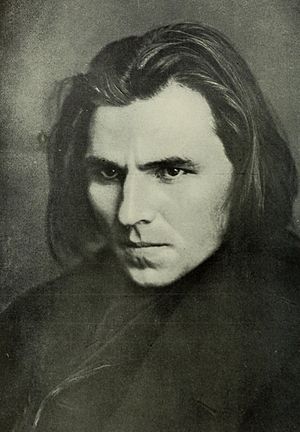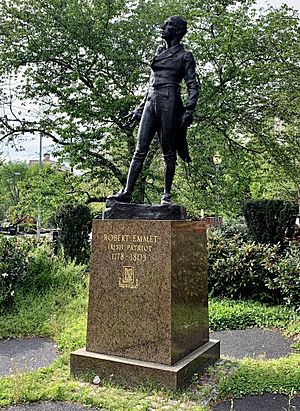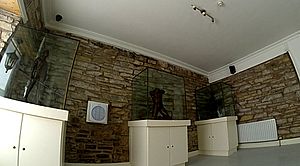Jerome Connor facts for kids
Quick facts for kids
Jerome Connor
|
|
|---|---|

Jerome Connor, c. 1903
|
|
| Born | 23 February 1874 Coumduff, Annascaul, County Kerry
|
| Died | 21 August 1943 (aged 69) Dublin
|
| Nationality | Irish |
| Known for | sculpture |
Jerome Connor (born February 23, 1874, in Coumduff, Annascaul, County Kerry – died August 21, 1943, in Dublin) was a very talented Irish sculptor. He created many famous statues, mostly out of bronze. His art often showed strong feelings and important ideas.
Contents
Jerome Connor: A Sculptor's Story
Early Life and Artistic Beginnings
Jerome Connor was born in a small village in County Kerry, Ireland. When he was about 14 years old, in 1888, he moved to Holyoke, Massachusetts in the United States. His father was a stonemason, someone who cuts and shapes stone. This likely inspired young Jerome.
In New York, Connor worked in many jobs that involved shaping materials. He was a sign painter, a stonecutter, and even worked with bronze and machines. As a child, he loved to carve figures into rocks using his father's tools. This early hobby showed his natural talent for sculpture.
It is thought that he helped create some big bronze works early on. These include a Civil War monument in Massachusetts and a large fountain at the Library of Congress in Washington, D.C..
Becoming a Known Artist
In 1899, Jerome Connor joined the Roycroft arts community. This was a group of artists and craftspeople. There, he first helped with blacksmithing, which is working with metal. Soon, he started making terracotta busts (sculptures of heads and shoulders) and reliefs (sculptures that stick out from a flat surface). He became known as the main sculptor at Roycroft.
One of his biggest projects there was called "The Marriage of Art and Industry." Connor spent almost a year working on this huge sculpture. It became very heavy. One evening, while he was working on the second floor of an old barn, the floor beams broke! The sculpture crashed down, but luckily, no one was hurt.
After four years at Roycroft, he worked with another famous designer, Gustav Stickley. Connor became very well known as a sculptor. He received many important jobs to create bronze statues for cities. These statues were placed in places like Washington, D.C., Syracuse, and San Francisco. In 1910, he opened his own art studio in Washington, D.C. From 1902 until he died, Connor made many designs. These ranged from small portraits to large public statues.
Connor taught himself how to sculpt. He was highly respected in the United States, where most of his public artworks can still be seen. People felt he was greatly influenced by another Irish American sculptor, Augustus Saint Gaudens. Connor used human figures to show feelings, values, and ideas. Many of his jobs were for public memorials and non-religious figures. He made them from bronze, which was different from the older Irish tradition of stone sculptures for churches.
Famous Works in America
Jerome Connor is known around the world for his sculptures. His most famous work is Nuns of the Battlefield. This large monument is located in Washington, D.C., in the United States. It honors the more than 600 nuns who cared for soldiers during the American Civil War. It is one of only two monuments in the area that show women's important roles in that war.
The idea for this sculpture was approved by the U.S. Congress in 1918. The government did not pay for it. Instead, a group called the Ancient Order of Hibernians raised $50,000 for the project. Jerome Connor was chosen because he often focused on Irish Catholic themes, just like the group.

Returning to Ireland
Connor worked in the United States until 1925. Then, he moved back to Dublin, Ireland, and opened his own studio. However, he found it hard to get enough money and people to buy his art. This caused his work to slow down.
In 1926, the Roycroft community asked him to create a statue of Elbert Hubbard. Hubbard and his wife had died when the ship RMS Lusitania sank. The statue was finished in 1930. Today, it stands in East Aurora, New York, near the Roycroft Chapel.
While working on the Hubbard statue, Connor also got a job to create a memorial for all the Lusitania victims. This memorial was planned for Cobh, County Cork, where many victims were buried. A committee in New York started the project. Connor died before the Lusitania memorial was finished. Another Irish artist completed it based on Connor's designs.
Remembering Jerome Connor
Throughout his life, Jerome Connor was known by several names. These included Patrick Jeremias Connor, Jerome Conner, Jerome Stanley Connor, J. Stanley Connor, and "St. Jerome" Connor.
He passed away on August 21, 1943, from heart failure. People say he died without much money. Today, there is a street in Dublin called "Jerome Connor Place." Also, nearby, there is a special plaque on Infirmary Road. It looks out over Dublin's Phoenix Park, which was his favorite place. The plaque has words written by his friend, the poet Patrick Kavanagh:
He sits in a corner of my memory
With his short pipe, holding it by the bowl,
And his sharp eye and his knotty fingers
And his laughing soul
Shining through the gaps of his crusty wall.
Important Sculptures
Here are some of Jerome Connor's public sculptures that you can see:
Sculptures in the United States
- Civil War Memorial, South Hadley, Massachusetts, 1897
- Bishop John Carroll, Georgetown University, Washington D.C., 1912
- The Supreme Sacrifice, Washington D.C., 1920
- Nuns of the Battlefield, Washington D.C., 1924
- Victory Memorial, The Bronx, New York City, 1925
- Elbert Hubbard, East Aurora, New York, 1930
Sculptures in Ireland
- Lusitania Peace Memorial, Cobh, started in 1936, finished in 1968
- Éire, Merrion Square, Dublin, put up in 1976
The Annascaul Collection
In 1990, a special group called the Jerome Connor Trust was created. It worked with the National Gallery of Ireland. Their goal was to own eight of Connor's bronze sculptures. They wanted to put them in a planned art gallery in Annascaul, his hometown. Later, the collection grew to include fourteen pieces.
A permanent place to show these sculptures was built at the South Pole Inn in Annascaul. This exhibition space was officially opened in April 2014. It also includes six pieces that are privately owned.
Images for kids






